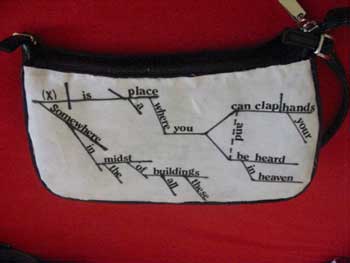
“Sentence Diagram Bag,” Kitten Wrangler, Flickr
The sentence patterns writers create can be simple or complex. Some of your reading for class probably contains long and intricate sentences with two or more main clauses, which are connected by conjunctions such as “and” and “but.” Writers sometimes build sentences with phrases and dependent clauses so that less important ideas connect to the main idea. Using a variety of syntax or sentence patterns, authors avoid monotony in their writing to make your reading experience better. Let’s do a quick review of clauses and phrases.
Clauses
“A clause is a group of words containing a subject and predicate and functioning as a member of a complex or compound sentence.” Merriam-Webster
To better understand this definition, let’s break it into these parts:
Group of Words – an ordered pattern of words
Subject – the person or thing that performs the action of the verb, or about which something is stated
Predicate – the part of a sentence or clause that expresses what is said about the subject, consisting of a verb with or without objects, complements, or adverbial modifiers
Example: In the sentence “The boy threw the stick,” the subject is “the boy” and the predicate is “threw the stick.”
Now that you have reviewed these terms, look at “dependent clause” and “independent clause.”
An independent clause, sometimes called a main clause, is one that contains a subject and a verb and that can stand alone as a complete sentence.
Example: Sandra studied in the library for her history exam.
A dependent clause is a clause that modifies a main or independent clause to which it is joined and that can also be called a subordinate clause.
Example: “When Sandra studied in the library for her history exam”
What happened when she studied? The thought is incomplete. Why is this example different from the one that precedes it? The word “When,” a subordinate conjunction, added to the independent clause changes it to a dependent clause. In other words, the clause is now incomplete and is dependent on another clause to form a complete sentence.
Perhaps this sounds complicated, but look at the list of commonly used subordinate conjunctions below. When you see one of these markers at the beginning of a sentence or in the middle of a longer sentence, you’re probably reading a dependent or subordinate clause.
Commonly used dependent marker words include the following: after, although, as, as if, because, before, even if, even though, if, in order to, since, though, unless, until, whatever, when, whenever, whether, and while.
To learn more about clauses, visit this link: http://owl.english.purdue.edu/owl/resource/598/01/.
Phrases
A phrase is a group of related words in a sentence that functions as a single part of speech. For example, in the sentence “The person on the stage is the conductor,” the phrase is “on the stage.” This particular example is a prepositional phrase. Here are several types of phrases that you should know:
- Prepositional Phrase: a phrase that begins with a preposition and ends with a noun or pronoun
Example: The man on the bridge is my father.
- Appositive Phrase: a noun or pronoun that identifies another noun or pronoun
Example: That book, the greatest novel ever written, was published over fifty years ago.
- Infinitive Phrase: a verbal phrase that usually begins with “to” and is followed by a verb
Example: To walk with him is to know fear.
- Participial Phrase: a verbal phrase that functions like an adjective
Example: Riding like lightning, I lost my senses.
- Gerund Phrase: a verb that ends in ‘ing’ and functions as a noun
Example: Flying is my favorite thing to do.
Phrase or Clause?
Choose whether the words in bold are phrases or clauses by clicking on the icon next to your response.
- The dog barked.
- To be with her is amazing.
- The coach jogs on Monday, and he lifts weights on Tuesday.
- She is going to the student meeting tomorrow.
- Fumbling the ball, the football player cost the team a touchdown.
- Simon is one of our best students.
- Delores cried because she had forgotten her homework.
- Telling a joke is a good way to ease tensions.